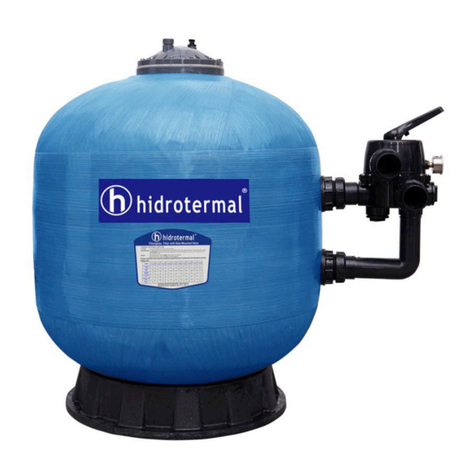CircuPool RJ PLUS series User manual

Electronic Chlorine Generator
RJ
+
PLUS Series

INTRODUCTION 1
GETTING STARTED 1
SAFETY INSTRUCTIONS 2
SYSTEM OVERVIEW 4
INSTALLATION
Preparing the Pool Water 5
Installing the Electrolytic Cell & Flow Switch 5
Installing the Control Module 7
Wiring 7
Adding Salt 10
Installation Checklist 12
OPERATION
How it Works 12
Initial Start Up 13
General Operation 13
Using the Control Module 14
MAINTENANCE
General Maintenance 17
Ideal Chemistry Levels 17
Maintaining the Electrolytic Cell 19
VOLTAGE CONVERSION 21
HELPFUL HINTS 22
TROUBLESHOOTING 24
WARRANTY 26
TABLE OF CONTENTS

1
RJ PLUS Series
Owner's Manual
Congratulations on your recent purchase of a CircuPool RJ PLUS Series
Electronic Chlorine Generator. CircuPool’s high performance systems
offer escape from the routine of manual pool chlorination and
sanitization. The RJ PLUS Series uses a low level of salt in the pool water
to continuously create free chlorine, killing bacteria and algae in the
water and helping to maintain a sparkling clean pool. Please take a
moment to read through the entire manual before installing your new
unit. Your generator must be installed and operated as specified.
READ ENTIRE MANUAL FIRST - As with any electrical device, it is very
important that the installation and service of this equipment be
performed by a qualified person with the skills and experience required
to do it safely and correctly. Improper installation or service can result
in severe electrical shock to the installer or user of the equipment or
pool. Please choose your installer with great care! Be sure to familiarize
yourself with the pool chemistry requirements and maintenance
procedures.
Please visit www. circupool.com/help for more information, useful tips, and
troubleshooting assistance.
INTRODUCTION
GETTING STARTED

2
.
IMPORTANT SAFETY INSTRUCTIONS. Read and follow
all instructions. Ensure all owners / operators of this
equipment have access to these instructions. Save all
instructions.
WARNING: Follow all aspects of local and National Electrical
Code(s) when installing the CircuPool RJ PLUS Series. Disconnect all
AC power during installation & service.
WARNING: To reduce the risk of injury, do not permit children to
operate this device. Service should only be attempted by a
qualified professional.
WARNING: Heavy pool (and/or spa) usage and higher
temperatures may require higher chlorine output to maintain
proper free available chlorine residuals. The actual amount of
chlorination required by your pool can change, and varies
according to factors not limited to bather load, rain, temperature,
dirt, debris, and chemical balance.
WARNING: Safe operation of the electrolytic cell requires a
minimum water flow rate of 20 gpm. Never operate the unit when
the flow of water is restricted. Always turn unit off when
operating any plumbing control valves such as for backwashing,
water exhaust, or during operation of spa or water features if
operation restricts water flow to the cell. A build-up of flammable
gases will result in hazardous conditions.
WARNING: We strongly recommend against the use of isolation
valves. If full pump pressure is applied to an isolated component,
it may be prone to rupture.
Before installation, ensure that materials and equipment used in
and around the pool are compatible with the use of chlorinated
water and salt. Avoid high chlorine and high salt levels (above the
recommended range); it is possible that certain materials and
pool (and/or spa) equipment may be susceptible to damage.
Ensure that the chlorinator operates only when the circulation
pump is operating. When installed with a pool equipment timer or
control system, the Control Module must be to the load side of
the timer clock or control relay.
SAFETY INSTRUCTIONS

3
If additional chlorine is required (due to heavy bather loads, for
example), use Sodium Hypochlorite to maintain an appropriate
chlorine residual in the water.
DO NOT add acid or other concentrated chemicals directly to the
skimmer. This may damage the cell.
Check the expiration date of any test kits as test results may be
inaccurate if used after that date.
When replacing the cell, only use replacement cells having a label
that clearly states that it is the replacement for this RJ/RJ PLUS
Series model.
Proper pool chemistry must be maintained at all times. For
outdoor pools, chlorine residuals can be protected from
destruction by sunlight by addition of stabilizer (Cyanuric acid).
Always add acid to water, never water to acid.
For proper sanitation, spas must be completely drained
periodically. The number of days between COMPLETE SPA
DRAINAGE is equal to the volume of the spa water in gallons,
divided by 10 times the maximum number of daily spa users. Refill
spa with water and repeat initial startup instructions on page 13
of this manual.
Ensure that the RJ PLUS Series installation does not constitute a
cross connection with the local potable water supply. Consult
local plumbing codes.
Note: Some local codes may require external grounding source.
Check your local ordinances.
A green colored terminal marked "Earth Ground" is located inside
the wiring compartment. To reduce the risk of electric shock, this
terminal must be connected to the grounding means provided in
the electric supply service panel with a continuous copper wire
equivalent in size to the circuit conductors supplying the
equipment.
One bonding lug for US models is provided on the external
surface. To reduce the risk of electric shock, connect the local
common bonding grid in the area of the swimming pool, spa, or
hot tub to these terminals with an insulated or bare copper
conductor not smaller than 8 AWG US.

4
.
There are three main components to your CircuPool RJ PLUS Series system: the Control
Module, the Electrolytic Cell, and the Flow Switch.
Control Module: This component supplies power to the cell and allows you customize
the system's operation, in order to meet your pool's unique needs.
Electrolytic Cell: This component creates chlorine as the water inside passes through
and returns to the pool. The Electrolytic Cell ("Cell") contains a set of titanium plates
that use a low level of electrical power to generate chlorine from salt in the water. The
Cell comes with Unions to connect to the plumbing; each Union has a Threaded Collar
that secures the Cell to the Unions, and enables the Cell to be easily removed for
cleaning and inspection purposes.
Flow Switch: This component ensures that there is adequate water flow for the Cell to
activate.
SYSTEM OVERVIEW

5
..
Preparing the Pool Water
It is important that the pool's water chemistry is balanced before the RJ
PLUS Series is powered on and used. When adding salt to the pool
water, see "Adding Salt" on page 10. For important information about
other water chemistry levels, see "Ideal Chemistry Levels" on page 17.
Installing the Electrolytic Cell and Flow Switch
From the supplied components, select the plumbing fittings that match
the existing pool plumbing
For proper plumbing, refer to the overview diagram on page 4. NOTE:
The following are basic plumbing instructions for the typical installation
(Configuration #1), which entail positioning the Flow Switch and Cell
adjacent to each other on 2" plumbing. Your installation may vary
depending on space available and your specific arrangement of
equipment. IMPORTANT: Ensure that the pool pump and all AC power
are turned off before installation.
TIP: Confirm installation layout first before cutting and gluing!
The Cell and Flow Switch are to be fitted into the return line as the last
pieces of equipment the water passes through before returning to the
pool: always after the pump, filter, heater (if applicable), etc. If a heater
is present, all equipment must be a minimum distance away, per heater
manufacturer recommendations.
Lay out your equipment to ensure there is enough pipe space available.
When positioning the Flow Switch, ensure at least 6 to 12” (30cm) of
straight pipe before the Flow Switch. If installed after the Electrolytic
Cell, the Cell provides this space. The raised arrow on the black plastic
cap must be pointed with the direction of water flow as it returns to
the pool. If installed horizontally, ensure that the wire-side faces
upwards. The Flow Switch is approximately 4" in length; the typical
gap required is 1 ¼".
When positioning the Cell, you can consider the side of the cell with
the cord the "inlet" side. If installed horizontally, ensure that the wire-
side faces upwards. From end to end, the Cell with both Unions is
approximately 15 ¾" in length; the typical gap required is 13 ¼".
INSTALLATION

6
Refer to the overview diagram on page 4 for alternate configurations.
For combined pool and spa systems with a spillover, configurations #2
or #3 allow chlorination for both the pool and spa during spillover but
preventing possible over-chlorination when operating the spa only.
Vertical Installation Kits are also available to minimize plumbing space
required and increase ease of installation (sold separately, available at
www.circupool.com).
TIP: Double-check that all Cell and Flow Switch cables can reach the
Control Panel.
Note: For installations with 1 ½" plumbing, use 2" to 1 ½" reducer
bushings with flow switch, and use alternate 1 ½" Cell Unions; be sure
to note any new or additional measurements before cutting pipe.
After determining the section of plumbing to install the Flow Switch and
Cell, measure out and mark the selected area.
1. To install the Flow Switch, cut out a section of pipe at the desired
installation location. Use PVC Primer to clean and prepare the pipe
ends and interior of Flow Switch. Using plumbing Solvent Cement,
glue the Flow Switch to the pipe ends. Ensure excess glue does not
become affixed to movable parts within Flow Switch. IMPORTANT:
To insure proper operation, verify that the arrow on the flow switch
(located on the black plastic) points in the direction of water flow;
the water flow must depress the hinged activator inside of the Flow
Switch. This portion is threaded and may be turned during service;
additional thread seal tape may be added if necessary.
2. To install the Cell Unions, cut out a section of pipe at the desired
installation location. Clean parts and plumbing with PVC Primer to
prepare the pipe ends and interior of Unions. Place the Threaded
Collars over the pipe ends. Using plumbing Solvent Cement, glue
one Union to the pipe end.

7
3. Hold the Cell and second Union up to the first, to gauge the correct
distance before gluing the second Union to the remaining pipe end.
Allow sufficient time for glue to dry.
Ensure that the O-rings are fitted to the Unions. Place the Electrolytic Cell
between the Unions and tighten the Collars onto the Cell. For a watertight
seal, do not over-tighten the Collars, and only tighten them by hand.
When using a Variable-Speed or Multi-Speed
pump on a low speed setting, or for general
circumstances where flow is less-than-adequate,
the cell must be inverted in order to ensure
adequate flow & efficient chlorine production.
Installing the Control Module
Mount the Control Module as close to the pump and
filtration system as possible. For safety concerns, do not
install the Control Module within 10 feet of the pool edges,
and follow all applicable codes. Verify that the Cell and Flow
Switch cables can reach the Control Module from the section
of pipe selected for plumbing.
Overview: Using screws, secure the Control Module's
mounting bracket at a comfortable level on a wall or vertical
support, at least 3 feet above ground level. Hang Controls on
bracket. Minimize direct exposure to rain, sunlight, water
runoff, and lawn sprinkler systems. As with most electronics,
avoid placing the controls in tightly enclosed spaces to avoid
a build-up of excess heat. For operation, the Control Module
may be wired in to the pump's power source so that both
turn on and off together, or energized continuously for use
with variable speed pumps (Flow switch will control Cell
power but lights will remain on). (see diagram on page 9).
TIP: Do not operate unit until all salt is dissolved in pool water
Wiring
Power must be shut off at the circuit breaker before performing any
wiring. Be sure to follow local and NEC/CEC electrical codes. The

8
CircuPool RJ-Series has been designed to easily wire into typical in-
ground pool systems. To provide safe operation, the unit must be
properly grounded and bonded.
Bonding:
A lug used for bonding is attached to the bottom of the RJ-Series
Control Module. The Control Module must be bonded with an 8 AWG
copper wire to the pool bonding system.
Electrolytic Cell and Flow Switch Connections:
The Cell and Flow Switch cables have easy plug-in connectors, which
attach easily to the Control Module. Refer to the diagram below for the
location of these connections.
Wiring to Power Source:
The Control Module comes with an un-terminated Power Cord (AC
Input) which is typically connected to an external timer, which will turn
the pump and Control Module on and off together. Have the Control
Module wired to the load side of the timer by a qualified person. See
the following diagram for typical wiring. See voltage warning on page 9.
The RJ-Series is shipped from the factory with a 240 VAC configuration.
If 120VAC is needed, move the internal jumpers as shown on page 21. If
unsure, seek professional advice.
When used with variable-speed or other electronically controlled
pumps, you may wish to wire the Control Module directly to your power
source. This will allow the pump to determine when the Cell is
energized or dormant by activation of the Flow Switch.

9
Always double-check the voltage of your power source.Connection to
improper voltage can: a) cause severe damage/harm, or b) cause lights
and screen to power on without system function.
In some parts of the United States and Canada, the Control Module
must be connected to a circuit protected by a Class A ground fault
interrupter (GFI). Check local codes before connecting.
At this point, this installation of your equipment is complete. If the
water has not yet been prepared, then you are ready to begin adding
salt and balancing your water chemistry. Turn to Control Module to the
Power Off mode until enough salt has been added to the water.
The following information will give you more information about the
process of adding salt. Be sure to familiarize yourself with your pool's
ideal chemistry levels, which play a critical role in the operation and
longevity of your pool and pool equipment. For more information, see
page 17.

10
tes
.
Adding Salt
IMPORTANT: Before adding salt, ALWAYS perform an independent water
test to measure pre-existing salt levels.
Use only evaporated, granulated, non-iodized salt (Sodium Chloride). The
purer the salt (at least 99%), the better the life and performance of the
Electrolytic Cell.
DO NOT add chemicals or salt directly to the skimmer. This may damage the
cell. If the Electrolytic Cell has already been installed, it should not be
turned on before adding salt. For pools, it is best to empty the required salt
into the shallow end of the pool and run the filter and pump simultaneously
in order to circulate the water and dissolve the salt (the RJ PLUS Series is to
remain off during this time period). Do not throw the salt bag into the
water as chemicals and inks on the bag can interfere with water balance.
Salt may take 24 - 48 hours to dissolve in summer, and longer in winter.
Finer granules of salt will dissolve faster than compressed pellets.
Water Softener salt (also known as Water Conditioning pellets) is an
economical way to buy large quantities of salt. However, only salt that is at
least 99% pure NaCl can be used. Pellets are compressed forms of
evaporated salt that may take longer to dissolve. Avoid using salt with anti-
caking agents (Sodium Ferrocyanide, also known as YPS or Yellow Prussiate
of Soda) that could cause discoloration of fittings and surface finishes in
pool. Do not use Calcium Chloride as a source of salt. Do not use Rock Salt;
insoluble impurities mixed with the rock salt can shorten the life of the unit.
Salt Levels
The CircuPool RJ PLUS Series can work within a broad salinity range,
from a minimum of 3000 ppm (parts per million), up to 4000 ppm.
However, the ideal level for operation is about 3500 ppm. To achieve
this level of salinity, add approximately 30 lbs of salt for every 1000
gallons of water (or 3.6 Kilograms of salt for every 1000 Liters). If you
are unsure of the number of gallons in your pool, double-check with the
following equations.
TIP: When adding large quantities of salt, start with an independent test
of the existing salinity level and add in portions, retesting at each stage.
INSTALLATION / ADDING SALT
6

11
Before adding salt, check your water for any existing salt content and add
according to the chart below. If too little salt is added, the result will be
reduced efficiency and a low level of chlorine production. In addition, operation
at low salt levels will reduce the longevity of the cell. The salt in your pool is
constantly recycled, and the loss of salt throughout the swimming season
should be small. This loss is due primarily to the addition of extra water to
replace water lost from splashing, backwashing, and draining. Salt is not lost
due to evaporation.
Calculating Gallons (Measurements in Feet)
Rectangular - Length x Width x Average Depth x 7.5
Round - Diameter x Diameter x Average Depth x 5.9
Oval - Length x Width x Average Depth x 6.7

12
.
□ Cell Unions installed and glued into pipe work.
□ Threaded Collars on either side of the Cell are hand tight.
□ Flow Switch is installed and oriented properly.
□ Control Module is affixed to wall and wired correctly.
□ Cell Cable and Flow Switch are connected to Control Module.
□ You have checked and confirmed that Control Module switches
ON and OFF concurrently with filter pump, or is energized
continuously for use with variable speed pump.
□ You have checked all connections and joints for leaks.
□ Sufficient salt has been added and fully dissolved and circulated
throughout pool water.
□ Pool has properly balanced water chemistry.
How it works
The RJ PLUS Series chlorine generator, by electrolysis, creates chlorine
to sanitize your pool from the salt molecules (NaCL) in your water. A
small electric charge is applied across a set of titanium plates inside the
Electrolytic Cell. This produces Sodium Hypochlorite (NaOCl). In water,
Sodium Hypochlorite dissociates into sodium (NA+) and hypochlorite
(OCl-) ions.
It is the hypochlorite ions that form with the hydrogen (H+) ions (from
the water) to form hypochlorous acid (HOCl), which is the active agent
that destroys bacteria and algae, and oxidizes organic matter. This form
of chlorine works quickly in the pipe, leaving only a mild residual in the
pool. In addition, the Electrolytic Cell continuously “shocks” the
incoming water- burning off any oils, organic matter, or other particles
that need to be oxidized.
Best of all, the process continuously recycles the salt: after cleaning the
pool, the original molecules reform and the whole process begins again.
The salt doesn't get used up!
INSTALLATION CHECKLIST
OPERATION
6

13
Initial Start Up
Once installation is complete, ensure that the added salt has been fully
dissolved in the pool (page 10), and that the pool is clean and chemically
balanced (page 17).
Apply power to the pool pump switch (or timer controls). This should
activate the system, and within moments the green LED lights for
"Power" and "Generating" should be illuminated. During this time, you
may also see the "No-Flow" light flash for up to 60 seconds as your
pump begins its operation.
To find the optimum Chlorine Output setting, start at a setting of 70%
and adjust as needed over the initial start up period. Measure your
available chlorine in the pool after two to three days, and adjust the
Chlorine Output level accordingly. If the available chlorine is too high,
lower the Output level; if the available chlorine is too low, raise the
Output level. It will take a few adjustments to find the ideal setting for
your pool. Once determined, it should only take minor adjustments
throughout the season.
General Operation
By familiarizing yourself with the operation of the RJ PLUS Series, you
can achieve the maximum performance for your pool. There are
typically three factors that you can control which directly contribute to
the free chlorine level that will be available in the pool:
1) The chosen percentage of Chlorine Output on the Control Module,
2) Hours of pump run-time each day, 3) Water chemistry balance,
including the amount of salt in the pool, and chemicals that minimize
chlorine demand, such as stabilizer level in the water. See "Ideal
Chemistry Levels" for more important information.
After making the initial adjustments to your chosen Chlorine Output
level, additional adjustments are typically only necessary due to
changing seasonal temperatures, or changes in pool use and bather
load. Ensure that your pump runs long enough each day to move at
least two times the amount of water in your pool through the filter
daily. This is typically more than a sufficient amount of time for
chlorination of the pool, but if the pool has high chlorine demand,

14
running the pool pump longer allows for more chlorination. Measure
your water chemistry and chlorine level on a regular basis.
Using the Control Module
CONTROL BUTTONS
1) Power:Use this button to manually power the system on or off.
2) Chlorine Output: Use the plus/minus buttons to raise/lower the
system's power setting (the rate of chlorine production), in order to
customize operation for your pool's needs.
3) Super CL: Temporarily boosts Chlorine Output to Maximum Power
for 24 hours, or until power is removed from the system.
4) Salinity: Displays the average measurement of the most recent
salinity levels in the pool water. The average is constantly being
updated by real-time salinity readings.
TIP: When first installed, this reading may display the last salinity
readings taken at the factory. This average will begin to update with
your pool's operation over the first 24 hours.

15
5) Winter Mode: Reduces the chosen Chlorine Output setting by half,
for periods of low chlorine demand during cool weather.
6) Select: While in the Menu, the left/right arrows change options for
Pool Temperature, Instant Salinity, and Cell Version.
7) Menu: Press sequentially to cycle through the following information:
1. Pool Temperature (xx degrees Fahrenheit or Celsius)
2. Cell Voltage (in many cases 21.0 to 27.0 volts when chlorine
is being generated, otherwise 16-31V)
3. Cell Current (in many cases 2.50 to 7.80 amps when chlorine
is being generated, otherwise 0 amps during normal rest
cycles.)
4. Real-Time Salinity reading ( xxxx ppm or x.x grams/Liter.)
5. System ID
6. Software revision level
7. Cell Version.
LED INDICATOR LIGHTS:
• Power: Located on the Power Button, this LED indicates that the
Control Module is receiving input power when illuminated.
SAFETY TIP: Using the Power Button to turn the system OFF does
not remove power from the control box. Always disconnect power
at the circuit breaker prior to attempting any service procedure.
• Generate: This LED is illuminated during normal operation, and
indicates that the system is able to generate chlorine. When flashing,
the pool water is either too hot or too cold for chlorine generation.
This light may be off during rest periods of the system's duty cycle.
• Super CL: Located on the Super CL Button, this LED is illuminated
when the Super CL mode has been activated.
• Winter Mode: Located on the Winter Mode Button (snow flake icon),
this LED is illuminated when the winter mode has been activated.

16
• Salinity: Located on the Salinity button, this LED is illuminated when
the button has been pressed to display the salt level reading.
• Remote: The part is controlled by a remote control system.
• No Flow: This LED is illuminated when the Flow Switch has detected
no flow. This causes the Cell to stop generating chlorine. A flashing
LED indicates that the flow is restored, but there will be a 60 second
delay before generation is reestablished.
• Lo Salt: When this LED is flashing, the salt level is near to its minimum
threshold, which is causing the Cell to operate at low efficiency. When
this LED is illuminated steadily, the salt level is too low and Cell has
shut down. The salt level must be raised before operation is restored.
See also "Check Cell" below. See page 10 for information about
adding salt.
• Hi Salt: When this LED is flashing, the salt level is higher than
necessary. When this LED is illuminated steadily, the salt level is too
high and the Cell has shut down. The pool water must be diluted with
fresh water before operation is restored. See also "Check Cell" below.
• Check Cell: This LED is illuminated when Cell efficiency is greatly
reduced. When illuminated, the Cell has stopped producing chlorine.
The Electrolytic Cell must be inspected and cleaned: remove power
from the system, and clean Cell according to the instructions on page
19. If after cleaning the Check Cell light comes back on after power is
restored to the system, verify salinity and Cell Version setting, and if
necessary clean cell again more thoroughly. It is possible for cleaning
to be necessary even if debris or mineral build-up isn't immediately
visible to the eye. Additionally, if poor and inadequate water flow
through the cell is not allowing titanium plates to be completely
covered by water, this will also cause the system to experience a high
amount of wear. If illuminated after thorough cleanings, verifying
system parameters and complete water coverage in cell, Cell
replacement may be necessary. This light takes priority over any
salinity indicators.

17
.
General Maintenance
To maintain maximum performance, it is recommended that you remove
and visually inspect the cell at least every 3-4 months. The RJ PLUS Series
will illuminate the “Check Cell” LED when cleaning is absolutely necessary.
The frequency of cleaning depends on your water chemistry and the
Saturation Index of the water. For most people, cleaning is only necessary
once or twice a season. If this is not the case for you, the pool water
chemistry is not balanced. Consult a pool professional for additional help.
The Electrolytic Cell has a self-cleaning feature incorporated into the
electronic control’s logic. This self-cleaning action will help to inhibit or
slow mineral build-up. In areas with very hard water (high calcium and/or
mineral content), and in pools with unbalanced water chemistry, the cell
may require more frequent cleaning (see below). If the “Check Cell” LED
remains on after a thorough cleaning, it may require additional cleaning,
or the cell may be at the end of its life cycle and may require
replacement.
See "Maintaining the Electrolytic Cell" for cleaning instructions.
Ideal Water Chemistry Levels
It is important to maintain these chemistry levels in order to ensure that
the pool can be enjoyed safely, and to prevent corrosion or scaling. The
only unique requirement for a pool with a chlorine generator is the low
level of salt (salinity) to be maintained in the water. It may be helpful to
provide the manual to any pool professional that you may have
performing chemical testing or service.
Swimming Pools Spas
Free Available Chlorine 1.0 - 3.0 ppm 3.0 - 5.0 ppm
Salinity 3000 - 4000 ppm 3000-4000 ppm
pH 7.2 - 7.8 7.2 - 7.8
Total Alkalinity 100 - 200 ppm 100 - 200 ppm
Calcium Hardness 200 - 400 ppm 150 - 450 ppm
Stabilizer (Cyanuric Acid) 50 - 75 ppm 50 - 75 ppm
Saturation Index -0.2 to +0.2 -0.2 to +0.2
MAINTENANCE

18
CHEMISTRY TIPS:
Chlorine Stabilizer (Cyanuric Acid)
Stabilizer is needed to maintain proper levels of chlorine; the sun’s UV
radiation can destroy unstabilized chlorine in as quickly as 2 hours.
Stabilizer should be maintained between 50-75 ppm.
Nitrates and Phosphates
These chemicals can cause extremely high chlorine demands and will
deplete chlorine from your pool. When present, they may even lower your
free chlorine levels to zero. Your local pool professional can test for Nitrates
and Phosphates, levels should be at zero.
Langelier Saturation Index
A calculated number used to predict the calcium carbonate stability of
water. If the index is higher than +0.2, it can cause excessive calcium scaling
on the salt cell. If the index is lower than -0.2, it can cause the water to be
corrosive to metals and minerals in the water, such as the titanium inside
the Cell.
Metals
Metals can cause the loss of chlorine. Also, metals can stain your pool and
tint your water. Have your local professional test and recommend methods
of removal.
Chloramines
Chloramines should not be present in pool water. When organic materials
are not fully oxidized by Free Chlorine, Chloramines are formed. This ties up
the Free Chlorine in your pool, and does not allow the chlorine in your pool
to disinfect. Chloramines also cloud pool water and burn the eyes. Super
Chlorinate (shock) to remove Chloramines at the initial startup of the pool.
pH Levels
pH produced by the Electrolytic Cell is close to neutral pH. However, other
factors usually cause the pH of the pool water to rise. Therefore the pH in a
saltwater pool tends to stabilize at approximately 7.8. This is within
national standards. If the pool pH rises above 7.8, have a pool professional
test to see if other factors such as high Calcium Hardness or Total Alkalinity
are the cause, and then balance accordingly.
Total Dissolved Solids (TDS)
Adding salt to pool water will raise the TDS level. While this does not
adversely affect the pool water chemistry or clarity, the pool professional
testing for TDS must be made aware that salt has been added. The
individual performing the TDS test will then subtract the salinity level to
arrive at the correct TDS level.
12
Table of contents
Popular Swimming Pool Filter manuals by other brands

Aqua Comfort Technologies
Aqua Comfort Technologies Auto-Chlor AC-4000 owner's manual
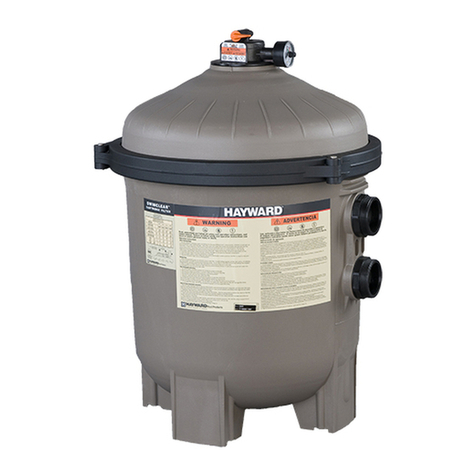
Hayward
Hayward SwimClear owner's manual
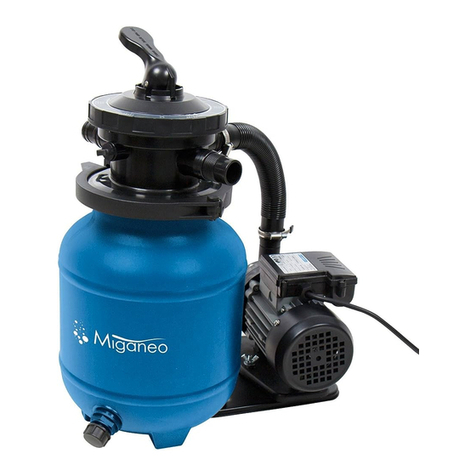
Miganeo
Miganeo Dynamic 6500 instruction manual
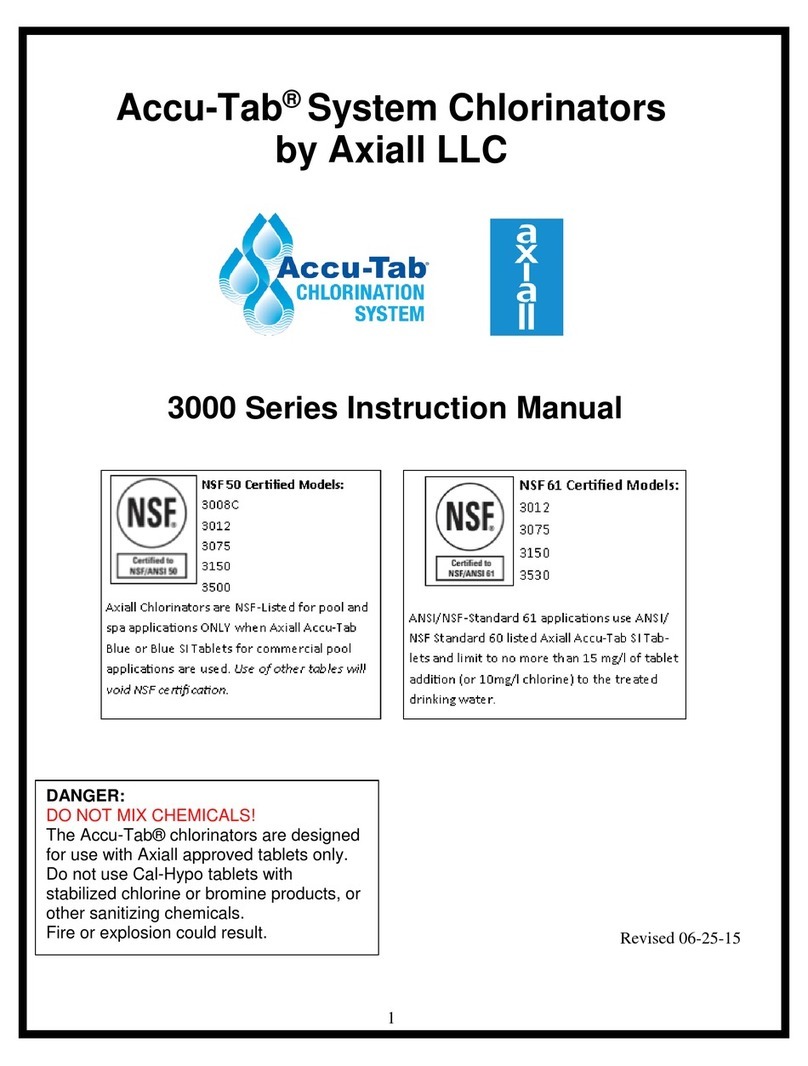
Axiall
Axiall Accu-Tab 3000 Series instruction manual
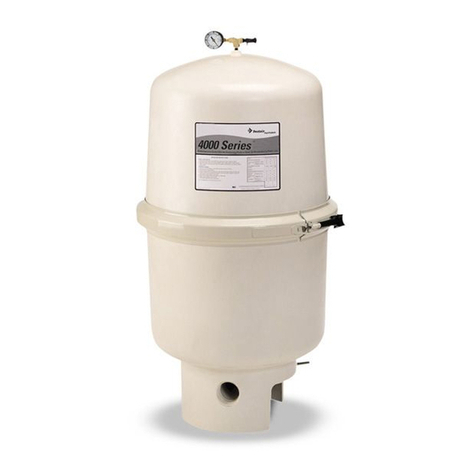
Pentair
Pentair SMBW 4000 Series operating manual
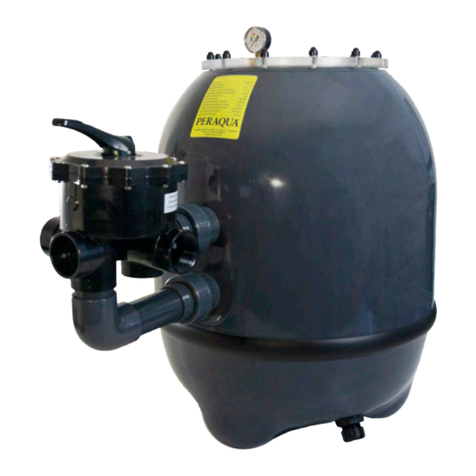
Peraqua
Peraqua BREGENZ 2 Installation & operating manual
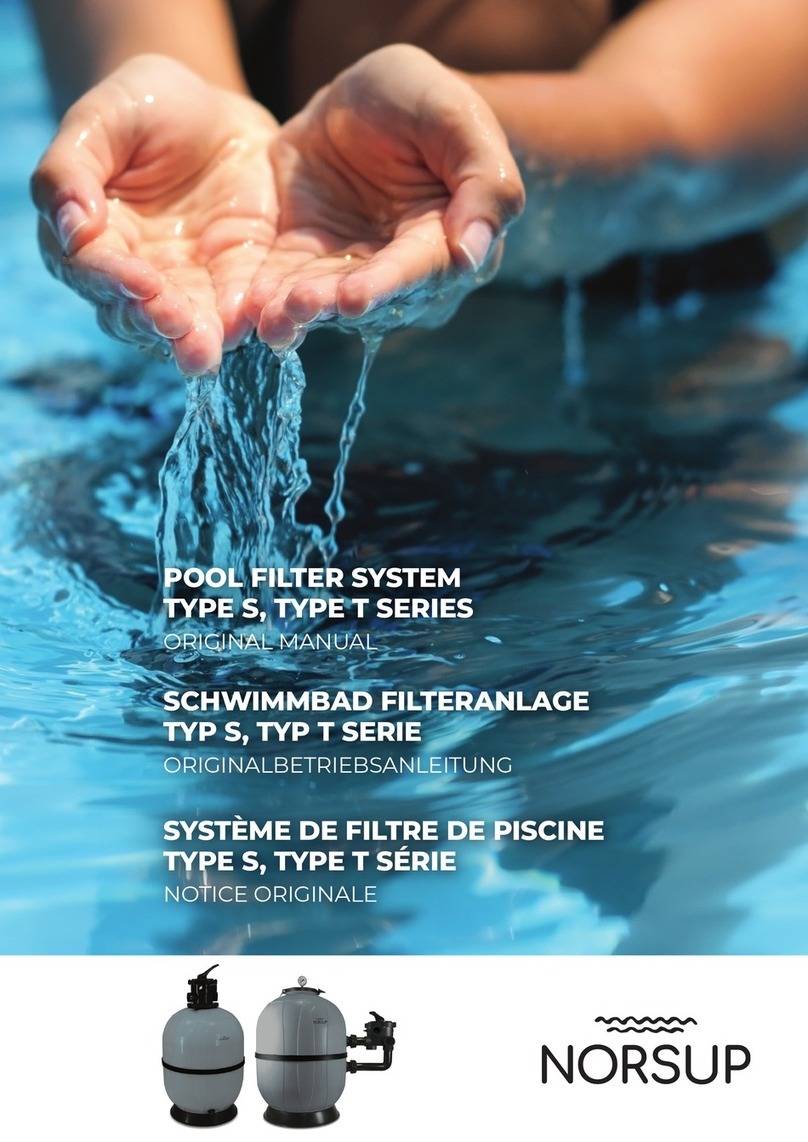
Norsup
Norsup S Series Original manual
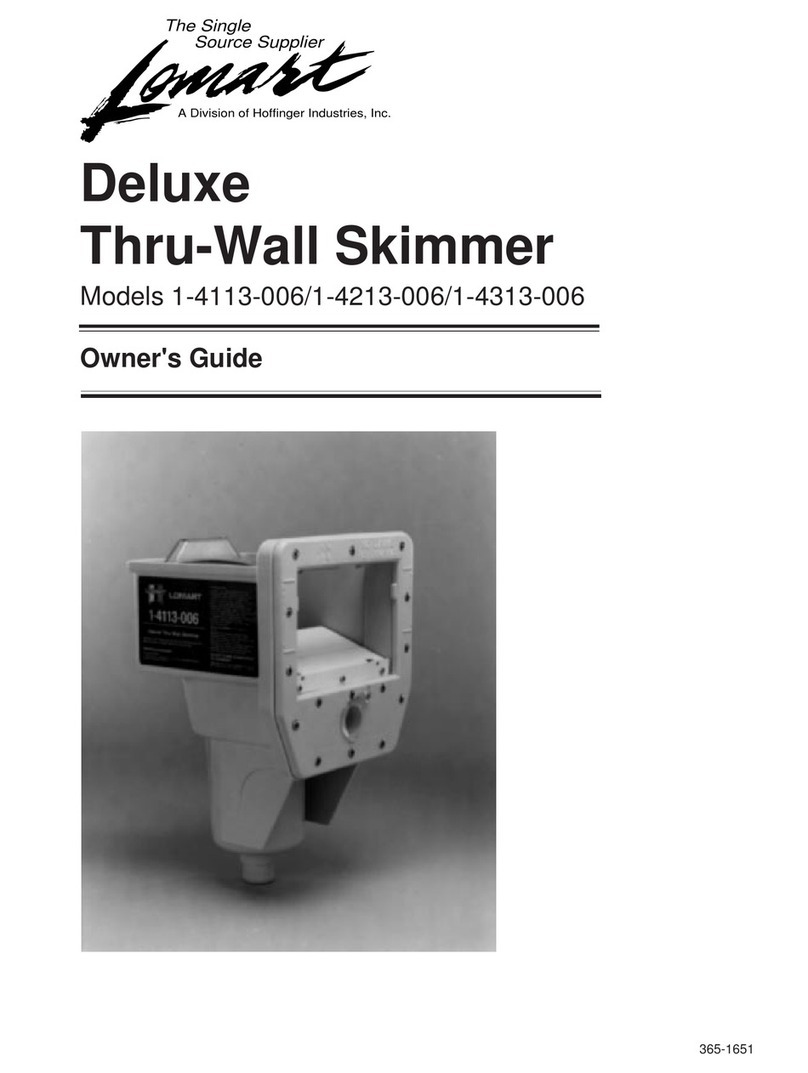
Lomart
Lomart Deluxe Thru-Wall Skimmer 1-4113-006 owner's guide
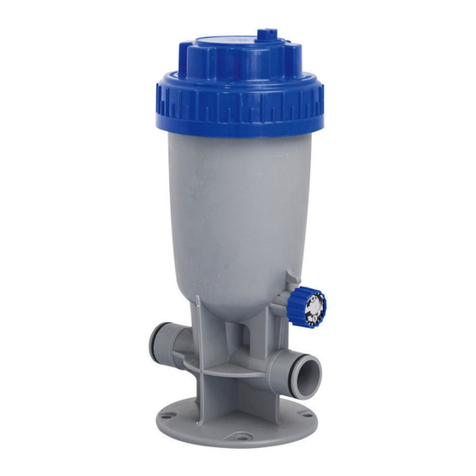
Bestway
Bestway AQUAFEED owner's manual

Pulsar
Pulsar PS-1HCE Operation and installation manual
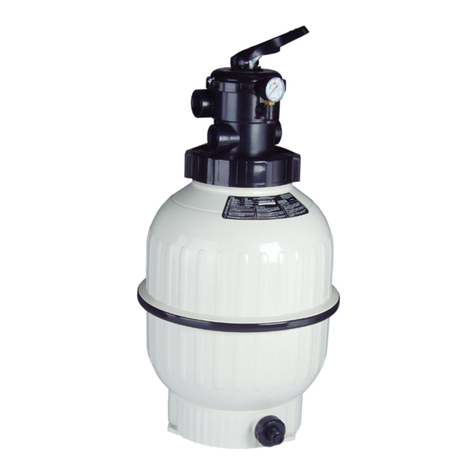
Astrapool
Astrapool 22399 Installation and maintenance manual
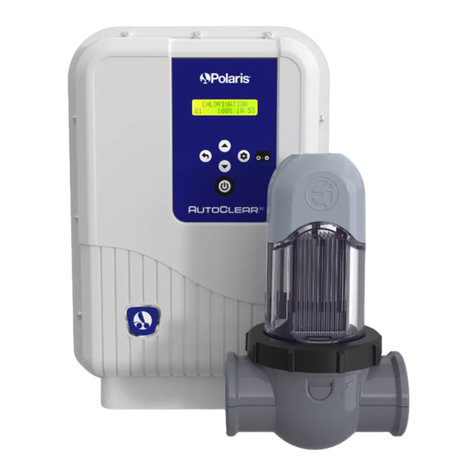
Polaris
Polaris AutoClear SC PAGSC20K Installation and operation manual




